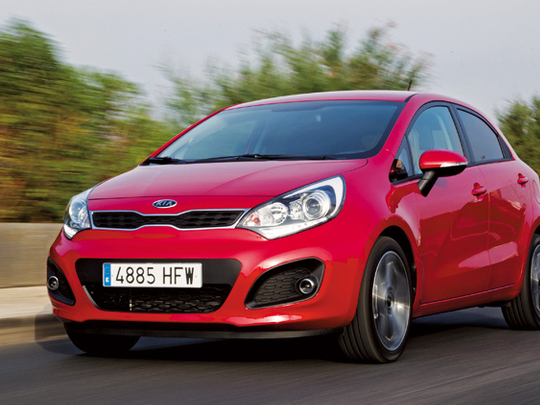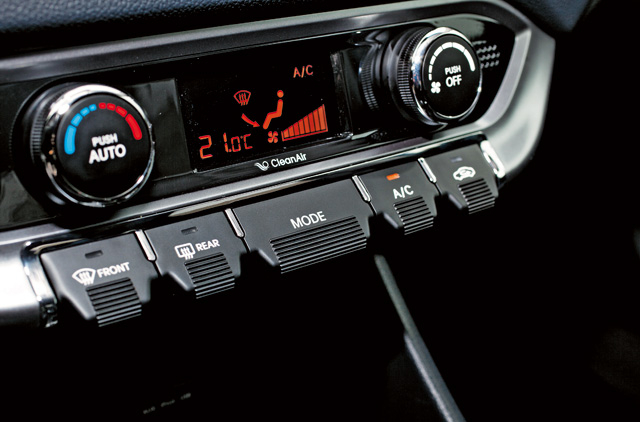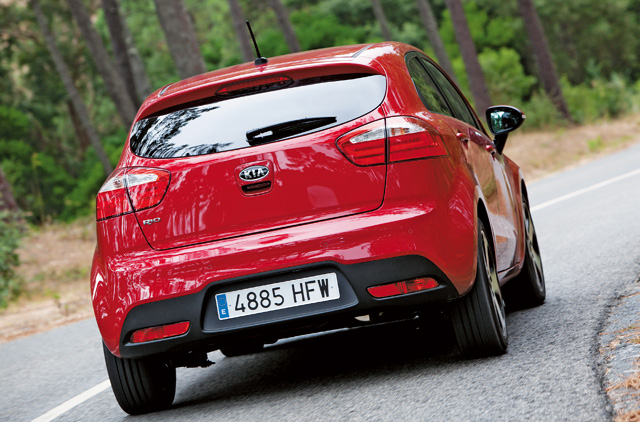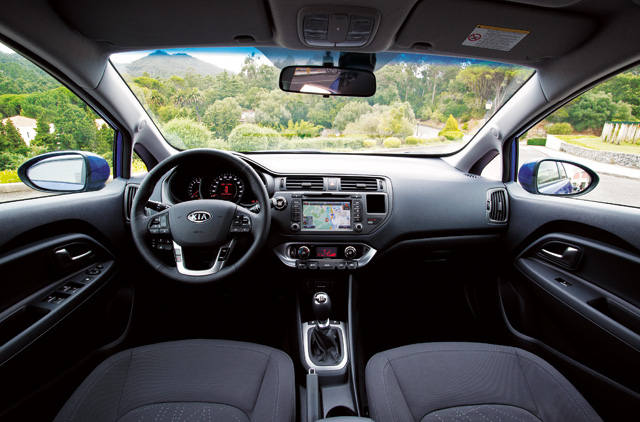
Kia used to make rubbish cars. And before the Korean press office lynches me, let me state that I have Kia's global communications main man, Michael Choo, on record as admitting exactly that. Psyche!
The company used to blatantly produce econoboxes that would shame actual cardboard boxes, with as much emotion and passion in its products as you might find in a toilet plunger. They did the job. That's it.
And that's why there isn't even any point bringing up the previous three generations of the Rio here, because making that association with the new car would be like recalling the 1933 Datsun Type 12 when basking in the comparative greatness of the Nissan GT-R.
This truly is a revolution in the compact car segment, because apparently the 4,045mm long Rio rivals things like the Toyota Yaris. After my lengthy drive in Lisbon, (Kia's European guys tossed me the keys and said, "See you later"), I see no reason why the Rio can't steal sales from the Volkswagen Golf, or Honda's Civic hatchback. And, having said that, you'll pass out when you hear the price.
Here's another reason why the Rio will be a huge success: the global B-segment market will continue to grow over the next few years, climbing to around 14 million sales by 2014. Who's taking bets on Kia having a piece of that pie?
I would wager everything I've got, because Peter Schreyer doesn't do ugly. And everyone knows that good design sells cars. With the new Rio, Kia has created an attractive compact that pays absolutely no heed to its predecessors. Those looked like hobo boots, whereas the new car is a Nike Air Max. Modern, aggressive, bold and unmistakably Kia with that signature grille, the only drawback I can come up with is that the rear looks too much like a Seat. Maybe Schreyer is still shaking off his VW Group days.
Either way it stands out with its lower profile and wider stance than before, sitting on aggressive five-spoke 17in wheels harking back to the original Audi TT. Again, some habits die hard, Schreyer. The reduced overhang (by 25mm) and increased ratio of body-to-glass help to give the Rio a raked posture, especially in three-door form. Unfortunately that doesn't matter to us as we're only getting the five-door.
But whatever the door count, you'll find the same interior in all Rios. And that's excellent, because I spent a whole day prodding and stroking everything, trying to figure out what Kia knows that no other carmaker in the world does. Have the Koreans perfected nanotechnology? The cabin of the Rio belongs at least in a class above, not only in terms of design but more importantly in terms of its fit and finish. All the panels are flush, the materials top rate and controls appropriately laid out. I especially love the AC switches, which possess a sprung firmness, as if you're prodding a stress ball. Ah, that feels so good…
The seating position is perfect too, with fine outward visibility thanks to the front quarter windows, while the steering wheel is adjustable for both rake and reach. It's also multifunctional, featuring toggle switches for the stereo that seem simply to work better than others.
At this point I should tell you about the ride, handling and performance, and you probably expect things to start dwindling. But, because we can throw the woefully underpowered 86bhp 1.2-litre (I never got beyond third gear in an hour of driving it) variant right out of the window — it's not available here — that leaves us to focus on the talented new 1.4-litre Gamma engine.
It isn't exactly a VAG TFSI, what with its 107bhp peak at 6,300rpm, but hey, the spec sheet still lists loads of friction-reducing internals, dual continuously variable valve timing, and 135Nm at 4,200rpm. And that last bit is the one that matters, because the 1.4-litre Rio stretches itself beyond your expectations when mated to the excellent and crunchy six-speed manual gearbox. Wishful thinking if you're interested in the manual 'box in the GCC, but because you're not, you'll be happy to know the car sold here has an automatic.
Get your launch right — and there really is nothing to it; switch off the electronics and drop the clutch — and you'll see 100kph in about 11 seconds, which feels pretty sprightly in something this compact. Especially in Portugal, where the locals drive as leisurely as they live — it's siesta time, all the time.
More relevantly, it's the mid-range punch offered by the torque that makes the Rio an entertaining drive, encouraging you to work the gearbox regularly in return for some smiles. The wider track and longer wheelbase serve up decent road-holding too, even though I'd have just ended up ruining the beautiful road-side scenery around Lisbon had I attempted to mimic my Group B heroes who raced here in the Eighties. Obviously, understeer rears its ugly head when you push the Rio hard, but drive it like an average Kia driver — sedately — and you get an impeccably behaved and eerily quiet and comfortable motor. Kia's noise and harshness department is obviously in for a generous bonus this year. The car's cabin is quieter and better insulated than some German executive saloons, and even the Continental tyres fitted to our European tester didn't ruin things.
Then there's the totally re-engineered suspension with MacPherson struts up front mounted on an isolated sub-frame. That helps to separate the road shocks from the occupants pretty much completely, as does the torsion beam rear axle, which is actually stiffer than on the old Rio, yet more pliable. Beats me, I never did understand suspension anyhow…
And at this point the only, (really, the only), problem with the Rio surfaces. The power steering doesn't use a power-sapping, crank-driven pump any more, instead it uses an electric system that helps to save fuel and frees up half a horsepower, or something. Yes, it requires just 2.82 turns lock-to-lock for more precise input but, unless you're Nostradamus, there's no way you'll be able to predict what in the world the Rio's steering is trying to tell you. To be honest, uncommunicative steering is the scourge of pretty much all modern cars, from several hot hatchbacks to even some full-blown supercars. And anyway, if you want telepathic steering, go and lift some weights and then buy something with a manual rack. You'll give up after a week.
Verdict
Don't be misled by the satellite navigation in that interior shot above; our GCC cars don't come with the privilege. Yet, as of next week, when the Rio makes it to our showrooms you'll be able to pick up a mid-spec model laden with just about everything else except a sunroof.
Oh hang on, I've just looked at the local spec list again. You don't get ABS… Uh-oh, I have to start this review all over again…
Seriously Kia, no ABS on a brand new 2012 model? Why are GCC customers so expendable to you? Don't you want us to live long enough to buy another Kia one day?
Seeing as I can't possibly recommend you buy a car without ABS in this day and age, even at the faint-inducingly low price of Dh48,500 (told you), you'll just have to wait until the showrooms get stock of the top-spec, ABS-equipped EX model.
Until then, make sure you find some cover, because this Korean storm isn't passing by quietly.
- Model Rio
- Engine 1.4-litre four-cylinder
- Transmission Six-speed manual, FWD
- Max power 107bhp @ 6,300rpm
- Max torque 135Nm @ 4,200rpm
- Top speed 185kph
- 0-100kph 11.0sec
- Price Dh45,800
- UAE friendly
- Plus Blinding value, build quality, cabin comfort
- Minus Slow, no ABS in base spec GCC models














